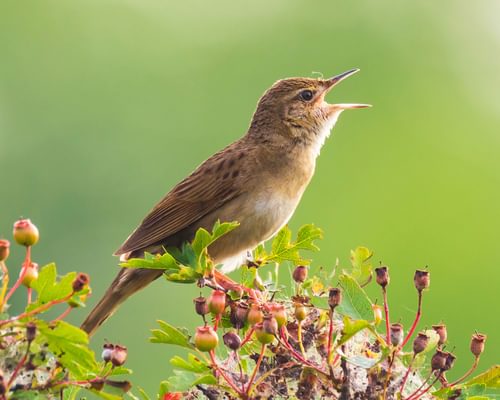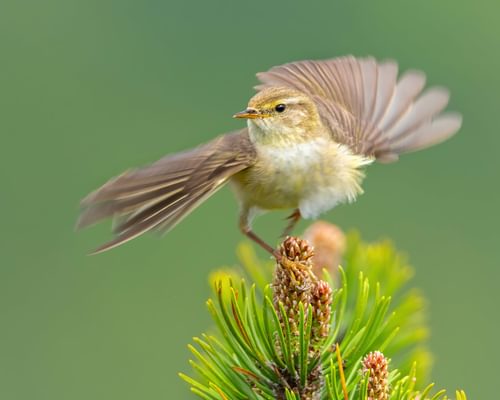Wood Warbler
Least ConcernPhylloscopus sibilatrix
Visual Identification
Appearance
The Wood Warbler is a small, slender bird with distinctive colouration. Its upperparts are a bright yellowish-green, contrasting sharply with pure white underparts. A prominent yellow supercilium (eyebrow stripe) and dark eye stripe enhance its facial features.
Both sexes look similar, with juveniles appearing slightly duller. During the breeding season, adults may show more vibrant plumage, with males occasionally displaying a slightly brighter yellow throat.
Size
Length
11cm to 12.5cm
Wingspan
20cm to 24cm
Weight
8g to 15g
Colours
Males and females have similar plumage
Primary Colour
Green Yellow
Secondary Colour
White Grey
Beak Colour
Brown
Leg Colour
Brown
Habitat and Distribution
Habitats
Woodland
Garden
Wetland
Coastal
Urban
Farmland
Grassland
Desert
Tundra
Rainforest
Mountain
Savanna
Distribution
Wood Warblers breed across much of Europe, from the UK and Scandinavia to western Russia. They prefer mature deciduous woodlands, particularly those dominated by beech and oak trees. In the UK, they are most common in western and northern areas.
These birds are long-distance migrants, wintering in tropical and subtropical forests of West and Central Africa. During migration, they may be spotted in a variety of wooded habitats across Europe and North Africa.
The highest concentrations of Wood Warblers in Britain are found in the oak woodlands of western Wales. Each spring, the Scottish borders and parts of northern England also welcome visiting breeding wood warblers. In Ireland, a small but well-established breeding ground can be found in County Wicklow on the east coast.
Elevation Range
Up to 1,500 meters
Climate zones
Temperate, Subtropical
Distribution Map
This map gives you a rough idea of where you might spot a Wood Warbler. The coloured areas show countries where these birds have been seen.
A few things to keep in mind:
- Birds might not be everywhere in the coloured areas, for example, they may be present around the coast of that country
- Where birds live can change with seasons and available food
- This map is quite simple - it doesn't show exact locations
We're working on making our maps even better! Soon, we hope to show you:
- More detailed maps for bigger countries, including state and region
- How birds move around during different seasons
Distribution by Region
Behaviour and Ecology
Bird Attributes
This feature is in beta. We'd love your feedback to improve it!
Share your thoughtsBird Attributes Explained
Our bird attributes system rates various aspects of a bird's capabilities on a scale of 0-100, based on data from field observations, scientific studies, and expert knowledge.
Attribute Categories:
- Agility: Manoeuvrability, speed, and grace in flight or movement.
- Strength: Physical power, often correlating with size and hunting abilities.
- Adaptability: Ability to thrive in various environments or changing conditions.
- Aggressiveness: Territorial behaviour and assertiveness, particularly during breeding seasons.
- Endurance: Stamina, often seen in migration patterns or foraging behaviours.
Understanding the Ratings:
- 0-20: Very Low
- 21-40: Low
- 41-60: Average
- 61-80: High
- 81-100: Very High
Remember, these attributes are relative to other bird species and don't necessarily indicate superiority.
Hover over the icon next to each attribute for more information.
Tap the icon next to each attribute for more information.
Agility
Reflects the bird's manoeuvrability, speed, and grace in flight or movement.
The Wood Warbler demonstrates remarkable agility, particularly in its foraging behaviour. Its ability to hover whilst feeding, catch insects mid-flight, and navigate swiftly through dense canopies indicates a high level of manoeuvrability and precision in flight.
Strength
Indicates the bird's physical power, often correlating with size and hunting abilities.
As a small, slender bird weighing between 8-15 grams, the Wood Warbler's strength is relatively low compared to larger avian species. However, it possesses sufficient strength for its size to perform its daily activities and long-distance migrations.
Adaptability
Represents the bird's ability to thrive in various environments or changing conditions.
Wood Warblers show good adaptability in their foraging techniques and ability to thrive in various deciduous woodland habitats across Europe. Their long-distance migration also demonstrates adaptability to different environments, though their specific habitat preferences suggest some limitations.
Aggressiveness
Measures the bird's territorial behaviour and assertiveness, particularly during breeding seasons.
Wood Warblers are not particularly known for aggressive behaviour. Males establish territories and perform displays during breeding season, which indicates some level of assertiveness, but they are not notably aggressive compared to other bird species.
Endurance
Reflects the bird's stamina, often seen in migration patterns or foraging behaviours.
The Wood Warbler's endurance is evidenced by its long-distance migration between Europe and sub-Saharan Africa. This journey, coupled with their active foraging behaviour and ability to hover while feeding, suggests a good level of stamina and energy efficiency.
Diet
Wood Warblers primarily feed on insects and their larvae, including caterpillars, spiders, earwigs, flies, and beetles. Flying insects, including mayflies, sawflies, damselflies and lacewings, are frequently caught by the sallying technique of pursuing prey and catching them mid-flight.
They forage mainly in the canopy, often hovering to pluck insects from leaves. During migration, they may supplement their diet with small berries. Fruits include buckthorn, plum, elder, bramble and bilberry.
Behaviour
Wood Warblers are known for their active foraging behaviour, constantly moving through the canopy in search of insects. They often hover while feeding, a characteristic that distinguishes them from other warblers.
During courtship, males perform a distinctive 'butterfly display', fluttering their wings while singing.
Vocalisation
The Wood Warbler's song is highly distinctive and often described as 'spinning coin-like'. It begins with a series of clear, descending 'sip-sip-sip' notes, increasing in speed and ending in a shivering trill 'si-si-si-si-si-si'. Their call is a soft, plaintive 'piu'.
Contact calls heard in aggression or nest defence include a harsh ‘pip’ or ‘sip’ sound.
Nesting & Breeding
Wood Warblers typically form monogamous pairs each breeding season, which begins in late April to early May. Males establish territories and attract females with their distinctive song and 'butterfly display'.
The nest is built by the female on or near the ground, often on a slope in woodland, concealed in ground-level vegetation or against a grassy tussock or fallen tree. It's a domed structure made of grass, leaves, and moss, lined with finer grasses and hair. Females lay 5-7 white eggs with dark speckles.
Incubation lasts about 13 days, primarily by the female. Both parents feed the chicks, which fledge after 12-13 days. They usually raise one brood per season.
Lifespan
The Wood Warbler typically lives for 2 to 4 years, with a maximum recorded lifespan of 10.2 years.
Like all birds, lifespan can be affected by factors including predation, habitat quality, disease, and access to food sources.
Conservation and Status
Global Conservation Status
While currently listed as Least Concern globally, Wood Warbler populations have declined in parts of Europe, including the UK. Habitat loss in both breeding and wintering grounds poses a significant threat.
Conservation efforts focus on protecting mature deciduous woodlands and studying their migration patterns.
Birdwatching Tips
- Look for Wood Warblers in deciduous woodlands, particularly those with beech and oak trees.
- Listen for their distinctive song, which starts with a series of repeated notes and ends in a trill.
- Observe their characteristic hovering behaviour while foraging.
- In the UK, watch for them in spring and summer, particularly in ancient woodlands.
Additional Information
Quick Facts
Other names:
Green Warbler
Family:
PhylloscopidaePredators
Wood Warblers face predation from various birds of prey, including Sparrowhawks and Hobbies. Ground-nesting makes them vulnerable to mammals such as foxes, stoats, and weasels.
Did You Know?
- Wood Warblers can catch insects mid-flight, demonstrating remarkable agility.
- They are one of the few warbler species that do not typically have a second brood.
- Despite their name, Wood Warblers are more closely related to leaf warblers than to New World warblers.
Was this bird profile helpful?
Your feedback helps us improve our content
Thanks for your feedback!
Your input helps us improve our content.
Community Experience
Community Ratings
No ratings yet - be the first to rate this bird!
Latest Community Reviews
No reviews yet
Sign in to be the first to review
Community Reviews
Create Your Free Account Welcome Back!
Join our community to rate birds and share your experiences. Creating an account is completely free and only takes a minute. Sign in to your account to rate birds and share your experiences with our community.
Your information is secure and will never be shared.
By creating an account, you agree to our Privacy Policy.
Similar Birds
References
- 2 3
website: BirdLife International. 2016. Phylloscopus sibilatrix. The IUCN Red List of Threatened Species 2016: e.T22715260A87668662.
View source - 4
report, 2015: EBCC
- 1
website, 2010: Fransson et al., EURING list of longevity records for European birds
View source


